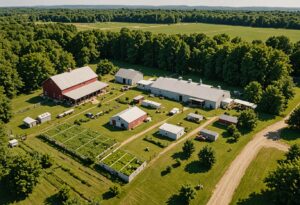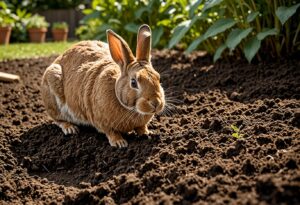
Introduction
Imagine standing on your sprawling 5-acre property, the sun setting behind your self-sufficient home, with the satisfaction that you’re not just living off the land, but doing so without contributing to the waste that burdens our planet. Sounds like a dream, right? But what if I told you that making your 5-acre property zero-waste is not only possible but can also be an incredibly rewarding journey? Zero-waste living, often associated with minimalism and urban environments, can thrive on larger properties like yours. Whether you’re new to sustainable living or a seasoned homesteader, this guide will help you navigate the steps needed to make your 5-acre property zero-waste. From composting your kitchen scraps to repurposing household items, we’ll dive deep into practical strategies that you can start implementing today.
Understanding Zero-Waste Living on a Larger Scale
Zero-waste living is all about minimizing the amount of trash you produce, ideally to the point where you send nothing to the landfill. For a 5-acre property, this concept takes on a broader meaning. You’re not just managing household waste; you’re also dealing with the byproducts of a more expansive lifestyle, which might include gardening, livestock, and perhaps even small-scale farming.
What Does Zero-Waste Mean for a 5-Acre Property?
On a larger property, zero-waste living means adopting a holistic approach to sustainability. It involves managing organic waste, reducing the need for non-renewable resources, and creating systems that recycle and repurpose materials naturally. The goal is to create a closed-loop system where nothing is wasted, and everything has a purpose.
Benefits of Adopting a Zero-Waste Lifestyle in a Rural Setting
While urban zero-waste efforts often focus on reducing single-use plastics and packaging, living on 5 acres allows you to expand your efforts. You can grow your own food, which reduces the need for store-bought items packaged in plastic. You can also compost organic waste on a larger scale, use rainwater harvesting systems, and even generate your own renewable energy. Additionally, the space you have allows for more extensive recycling and repurposing projects that wouldn’t be feasible in a smaller urban setting.
Challenges and Misconceptions About Zero-Waste on Larger Properties
One common misconception is that zero-waste living is only for people with small homes and minimal lifestyles. However, larger properties offer unique opportunities for sustainability. The challenges, such as managing a more complex waste system or finding the right balance between sustainability and convenience, are offset by the benefits of having more space to implement effective waste reduction strategies.
Waste Reduction Strategies for Your 5 Acres
Reducing waste is the first step toward a zero-waste lifestyle. It’s about making conscious decisions to minimize the waste you produce in your daily activities.
Conducting a Waste Audit
Identifying Sources of Waste on Your Property Before you can start reducing waste, you need to know where it’s coming from. Conducting a waste audit involves tracking everything you throw away for a week. This can help you identify the main sources of waste on your property—be it food scraps, packaging, or something else. Once you know where your waste is coming from, you can start addressing it directly.
Tips for Reducing Waste in Daily Homestead Activities
- Use reusable containers and tools: Instead of single-use plastic bags, opt for glass jars or metal containers for food storage.
- Buy in bulk: Purchase items like grains, nuts, and seeds in bulk to reduce packaging waste.
- DIY solutions: Make your own cleaning products and personal care items to cut down on the plastic containers and packaging.
Sustainable Shopping
How to Minimize Packaging and Buy in Bulk When you’re living on a 5-acre property, you might have access to local markets or even be growing your own food. Buying in bulk or directly from producers can significantly reduce packaging waste. Consider setting up a bulk pantry with large storage containers for dry goods, and bring your own bags when shopping. Additionally, growing your own food and preserving it—by canning, drying, or freezing—further reduces the need for store-bought items.
Composting and Organic Waste Management
Composting is the backbone of a zero-waste homestead. It turns organic waste into valuable compost that can enrich your soil, reduce the need for chemical fertilizers, and cut down on the waste you send to the landfill.
Setting Up a Composting System on Your 5-Acre Property
With 5 acres, you have the space to set up an extensive composting system. You can compost a wide variety of organic materials, from kitchen scraps to yard waste and even manure if you have livestock. A good composting system balances “green” materials (like fruit and vegetable scraps) with “brown” materials (like leaves, straw, and cardboard). You can choose from different types of composting systems, such as:
- Traditional compost piles: These are simple to set up and can handle large amounts of waste.
- Compost bins: These are more contained and can keep the composting process neater.
- Vermiculture (worm composting): This is ideal for kitchen scraps and can be done on a smaller scale.
Vermiculture vs. Traditional Composting: Which Is Best for You?
Vermiculture uses worms to break down organic matter and is excellent for composting kitchen scraps in smaller amounts. It produces rich compost, known as worm castings, which is incredibly beneficial for gardens. On the other hand, traditional composting can handle larger volumes and a wider variety of materials, making it more suitable for a 5-acre property where you might have a mix of garden waste, livestock manure, and household organic waste. The choice depends on your specific needs and the type of waste you generate most.
Managing Livestock Waste: Manure Composting and Its Benefits
If you have livestock, manure can be a significant source of waste. However, it’s also a valuable resource. Manure composting can reduce waste and produce nutrient-rich compost that’s excellent for gardens and crops. Proper composting of manure involves managing the pile to ensure it reaches the right temperature to kill pathogens and weed seeds. Once composted, manure can be safely applied to your garden to enhance soil fertility.
Recycling and Repurposing Waste Materials
Recycling and repurposing are essential components of zero-waste living, helping you manage the waste that can’t be composted.
How to Establish an Efficient Recycling System on Your Property
On a 5-acre property, you can set up a comprehensive recycling system. Start by sorting recyclables at the source—glass, metal, paper, and plastics should be separated. If local recycling programs are limited, consider ways to reduce the amount of non-recyclable waste you produce in the first place. You can also explore creative ways to recycle materials at home, such as:
- Building with reclaimed materials: Use old wood, metal, or bricks for DIY projects.
- Creating art from waste: Turn scrap materials into decorations or functional items.
- Recycling greywater: Use water from sinks, showers, and washing machines for irrigation.
Creative Ways to Repurpose Household Waste for Homestead Projects
Repurposing is a creative and resourceful way to reduce waste. For example, old pallets can be turned into garden beds, while glass jars can be used for storage or as planters. Even items like worn-out clothes can be repurposed—cut them into rags, use them for patchwork, or turn them into garden ties.
Turning Waste into Resources: DIY Recycling Projects to Try
- Making eco-bricks: Fill plastic bottles with non-recyclable waste to create sturdy building materials.
- Creating compost tumblers: Use old barrels to make rotating compost bins.
- Upcycling furniture: Give old furniture a new life with some paint and creativity.
Eco-Friendly Landscaping and Garden Practices
Your 5-acre property offers plenty of space to implement eco-friendly landscaping practices that contribute to a zero-waste lifestyle.
Building a Zero-Waste Garden: Mulching, Composting, and Natural Fertilizers
A zero-waste garden is designed to recycle its own nutrients and reduce the need for external inputs. Start by mulching with organic materials like leaves, straw, or wood chips. This not only suppresses weeds but also returns nutrients to the soil as it decomposes. Use compost and manure from your homestead to fertilize your garden naturally. Avoid synthetic fertilizers and pesticides, which contribute to pollution and waste.
Water Conservation Tips for Sustainable Landscaping
Water is a precious resource, especially on a large property. Implementing water-saving techniques is crucial. Consider using:
- Drip irrigation systems: These deliver water directly to the plant roots, minimizing evaporation.
- Rainwater harvesting: Collect and store rainwater for use in your garden.
- Drought-tolerant plants: Choose native or drought-resistant plants that require less water.
How to Incorporate Permaculture Principles into Your Garden Design
Permaculture is a sustainable farming system that emphasizes working with nature. On a 5-acre property, you can design a permaculture garden that maximizes productivity while minimizing waste. Key principles include:
- Zoning: Place elements of your homestead according to how often you use them, with high-maintenance plants and animals near the house and less frequently tended areas farther away.
- Polyculture: Grow a mix of plants together to enhance biodiversity and reduce the need for pesticides.
- Water management: Create swales, ponds, and other water features that help capture and store rainwater.
Green Building and Construction on a 5-Acre Property
When building or renovating on a 5-acre property, consider eco-friendly materials and methods that contribute to a zero-waste lifestyle.
Choosing Sustainable Building Materials for Zero-Waste Construction
Opt for materials that are renewable, recycled, or have a low environmental impact. Some excellent options include:
- Bamboo: A fast-growing, renewable resource that’s great for flooring and construction.
- Recycled steel: Durable and strong, it can be used for framing and roofing.
- Reclaimed wood: Perfect for building projects, reclaimed wood reduces the demand for new timber and adds a rustic charm.
DIY Projects: How to Build with Reclaimed and Recycled Materials
Building with reclaimed materials is a cost-effective and eco-friendly way to construct on your property. You can use old windows to create a greenhouse, or repurpose shipping containers for storage or even living spaces. The possibilities are endless, and each project helps reduce the amount of waste that would otherwise end up in a landfill.
Energy-Efficient Designs: Reducing Waste in Your Home’s Energy Consumption
Energy efficiency is a key aspect of zero-waste living. Designing your home or outbuildings with energy efficiency in mind can reduce your reliance on non-renewable energy sources and lower your overall waste. Consider:
- Passive solar design: Position your home to maximize natural light and heat.
- Insulation: Proper insulation reduces the need for heating and cooling, saving energy.
- Solar panels: Harness the sun’s energy to power your home.
Sustainable Living: Off-Grid Waste Management Solutions
Living off-grid doesn’t mean you have to compromise on waste management. In fact, it can enhance your zero-waste efforts.
How to Manage Sewage and Wastewater Sustainably
Sewage and wastewater can be significant sources of waste if not managed properly. Composting toilets are an excellent option for reducing water usage and creating compost. Greywater systems, which recycle water from sinks, showers, and washing machines, can be used to irrigate your garden.
Implementing a Rainwater Harvesting System on Your Property
Rainwater harvesting is a sustainable way to manage water waste. Install a rainwater collection system to capture water from your roof, which can then be used for irrigation, livestock, or even household use with proper filtration.
Off-Grid Energy Solutions: Solar, Wind, and Other Renewable Sources
Renewable energy is a cornerstone of off-grid living. Solar panels, wind turbines, and micro-hydro systems can generate electricity without contributing to waste. These systems not only reduce your reliance on fossil fuels but also help you manage energy more efficiently, contributing to a zero-waste lifestyle.
Maintaining a Zero-Waste Lifestyle: Tips for Long-Term Success
Adopting a zero-waste lifestyle is a long-term commitment that requires ongoing effort and dedication.
How to Stay Committed to a Zero-Waste Lifestyle
Staying committed means continuously looking for ways to reduce waste. This might involve setting new goals each year, such as reducing your plastic consumption by 50% or starting a new recycling project. It’s also helpful to track your progress and celebrate small victories along the way.
Engaging Your Family and Community in Sustainable Practices
Zero-waste living is easier when everyone is on board. Encourage your family to participate by making it fun and educational. You can also reach out to your community to share tips, swap materials, and collaborate on larger projects, such as a community garden or recycling program.
Resources and Tools to Help You Maintain Your Zero-Waste Goals
There are many resources available to help you stay on track. Online communities, books, and apps can provide inspiration, while local workshops and events can offer hands-on learning opportunities. Keeping up with the latest trends and innovations in sustainable living will also help you stay motivated and informed.
Conclusion
Achieving a zero-waste lifestyle on your 5-acre property might seem like a daunting task, but with the right strategies, it’s entirely within your reach. By implementing the practices outlined in this guide—from composting and recycling to green building and off-grid living—you can significantly reduce your environmental impact. Remember, zero-waste is not about perfection; it’s about progress. Each small step you take brings you closer to a sustainable, self-sufficient lifestyle. So why wait? Start today, and watch as your property transforms into a model of zero-waste living, one sustainable choice at a time.
10 Frequently Asked Questions (FAQs)
Zero-waste living involves minimizing the waste you produce to the point where nothing goes to the landfill. It focuses on reducing, reusing, and recycling as much as possible.
Begin by setting up a composting system that suits your needs. You can use traditional compost piles, compost bins, or vermiculture, depending on the type and amount of organic waste you generate.
Yes! Manure composting is a great way to manage livestock waste sustainably. It reduces waste and produces valuable compost for your garden.
Sustainable materials like bamboo, recycled steel, and reclaimed wood are excellent choices for green building projects. They reduce the demand for new resources and minimize environmental impact.
Implementing water-saving techniques like drip irrigation, rainwater harvesting, and choosing drought-tolerant plants can significantly reduce water waste on your property.
Absolutely. Off-grid living can enhance your zero-waste efforts by allowing you to generate your own renewable energy and manage waste more effectively with composting toilets and greywater systems.
Make it a fun and educational experience. Set goals together, try new sustainable practices, and celebrate your successes as a family.
A zero-waste garden recycles its own nutrients, reduces the need for external inputs, and minimizes waste. It’s more sustainable and can save you money in the long run.
Get creative! Use old materials for DIY projects, upcycle furniture, or create art. Repurposing is all about finding new uses for items that would otherwise be discarded.
There are many online communities, books, and apps dedicated to zero-waste living. Local workshops and events are also great places to learn and connect with others on the same journey.




